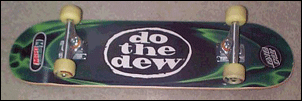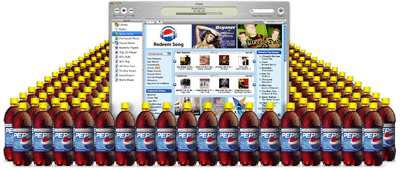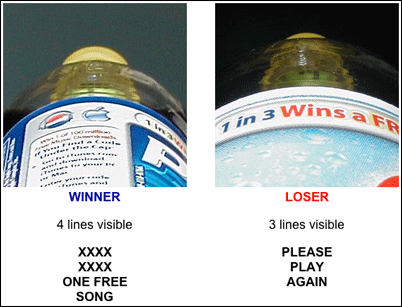I should preface the following story by explaining to anyone who doesn’t live in Michigan, New York, Oregon, California, Iowa, Delaware, Massachusets, Connecticut, Vermont, or Maine that in these states we pay a deposit on every can and bottle we buy, and that deposit is refunded upon the container’s return. Anyone who has seen the Seinfeld episodes dealing with Kramer’s efforts to gather empties in non-deposit states already knows about this, but I’ve always been amazed at how.. well, AMAZED so many out-of-towners are at the deposit / refund procedure when it is explained to them.
This is important because the bulk of this post deals with soda /pop bottles. For all four years of my highschool career, I worked at the local grocery store. In those days, the bottle return machines that are unavoidable now had not yet made it into the smaller suburban chain stores, so the bottle return functions were handled by humans. This particular detail was of the utmost importance during the year Pepsi offered it’s ‘Pepsi Points’ promotion.
This promotion should be familiar (In principle) to any smoker – a company includes points of various denomination with its products, and the customer can exchange a set number of accumulated points for various promotional products. The thing with soda / pop cap promotions is that americans drink so much damn pop / soda, that 90% of them never bother to look at the cap. During the Pepsi Points promotion, the plastic bottle caps were good for anywhere from 1 to 20 points (usually 1), whereas the boxes containg 12 cans – which people often reused to return their cans – were worth a guaranteed 10. Given our proximity to an endless source of pepsi points, it should come as no surprise that basically everyone employed there was madly hoarding caps.
I ended up with thousands of Pepsi points by the time the deadline came. I exchanged them for the Skateboard despite the fact that by then I had long given up on my quest to master the kickflip. The board was manufactured by Santa Cruz – so it wasn’t some no name board, and my younger brother ended up getting a lot of use out of it. I actually found a photo of one here, and as you can see it’s pretty GNARLY.

I had to work on the day of the deadline, so my Mom offered to take my carton o’ points to the post office for me. For some reason it never occurred to either of us that a LOT of people would also be waiting for the last day of the promotion to mail in their points. The post office was overrun with Pepsi enthusiasts.
The Pepsi Point contest also spawned one of those stories where someone spies a loophole in the rules of a corporate sponsored contest and then ruthlessly exploits it, to the joy of internet folk everywhere. The story of the man who accumulated an obscenely large quantity of frequent flyer miles via a loophole in a similar contest was all over the internet before eventually finding its way into P.T. Anderson’s ‘Punch Drunk Love.’ The keys to the Pepsi contest loophole lay in the fact that you could purchase additional points, and Pepsi’s television commercials for the contest:
“As most of you know, Pepsi ran a promotion in which “Pepsi points” could be redeemed for merchandise. In a commercial they ran, they listed some of the merchandise that could be bought, concluding with a Harrier “Jump Jet” for 7 million Pepsi points. The rules of the promotion
stated that a purchaser of any given piece of merchandise must redeem at least 15 original Pepsi points, but could purchase any additional
points needed to purchase the item from PepsiCo at a price of US$.10 each.So, on March 28, 1996, John Leonard submitted a Pepsi Stuff order form along with 15 original pepsi points, and a check for US$700,008.50 for
the remaining Pepsi points and shipping and handling charges. On May 7 of the same year, Pepsi refused to deliver the Harrier jet, returning his check and giving him a coupon for three free cases of pepsi as consolation.Leonard resubmitted on May 14, and Pepsi refused again. Leonard submitted the request a third time, got turned down again, and then filed suit against PepsiCo for breach of contract and fraud.
The only actual case file I can find on this is located at http://www.fcsl.edu/cdr2web/leonard.php3, which purports to be a copy of case #96-44518 in the United States District Court, Southern District of New York. I can’t find anything on this, or for that
particular court, anywhere on government pages (granted, I didn’t look all that hard).
CNN did some coverage of the story at the time, running a story quoting Pentagon officials as stating that even were John Leonard to win the case, Pepsi would not be able to acquire a Harrier jet, as they are illegal to own by private citizens. That story is here.” [From Will England’s Site]
Snope’s has a bit on the final ruling here:
“In August 1999, the New York judge upheld Pepsi’s case. “No objective person could reasonably have concluded that the commercial actually offered consumers a Harrier jet,” U.S. District Judge Kimba Wood said.
Not that Leonard would have ended up with the full jet anyway if things had gone his way — the Pentagon quashed the promotion in September 1997 when it announced that these $33.8 million jets are not for sale in flyable shape. Harriers take off and land vertically. But the Pentagon said any of the Marine aircraft would have to be “demilitarized” before being offered to the public, which means stripping them of their armament and rendering them unable to fly.”
Another Pepsi contest that was ruthlessly exploited by the employees of this particular grocery store was the ‘perpetual 20 ounce.’ This involved the contest where things like “You’ve won a free 20 Oz.!” are printed beneath the caps of 20 Oz. bottles of Pepsi. It was discovered that by some flaw in the design of pepsi bottles, one could ‘cheat.’
By holding the bottle at a certain angle above one’s head, you could clearly make out which bottles were winners, and which weren’t. By this process, the ‘perpetual 20 Oz.’ was born. One could purchase the first winner for an outlay of $0.79 plus 10 cents deposit, and then by carefully selecting winners each time, drink for free for the duration of the contest. Good times.

It is with these anecdotes in mind that I bring up the subject of Pepsi’s current promotion in cooperation with apple – the iTunes free song giveaway. Under pepsi caps bearing the iTunes promotional design, you have a 1 in 3 chance of winning a free song, with a limit of 200 per person over the course of the promotion. Additionally, the fountain cups at 7-11 stores offer another opportunity to win, and you don’t even have to drink pepsi products. The caps went into circulation shortly before the superbowl, but they seem to be a bit slow in making it to certain areas. There is a site keeping an updated map of where winners have been found here, and a store locater here.
Given my previous experience with such contests, it was no surprise that someone immediately applied the ‘perpetual 20 Oz’ principle to this contest, determining that winning caps had 4 lines of text and losers have 3. There’s a convenient demonstration of this technique here (Ironically hosted on Apple’s Servers).
Also of interest is Tune Recycler. Given the previously stated lack of interest of the general public, many of these caps will go unused. If you are aware of the promotion but don’t really feel like cashing in your caps, you can donate them so that the credit will be put towards artists on independent labels.
